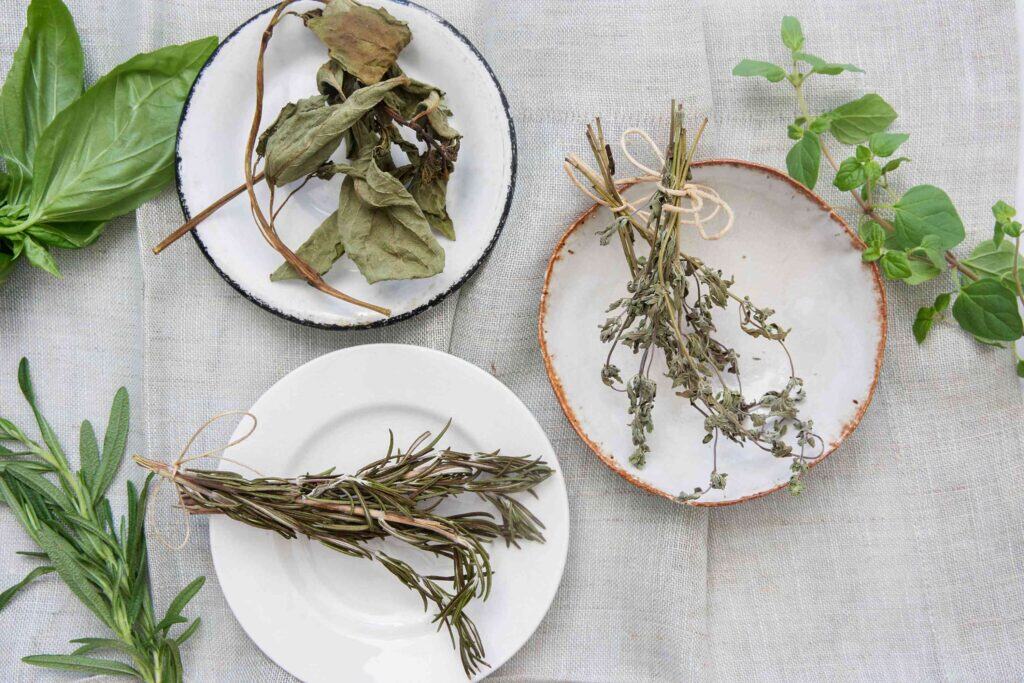SUMMARY: Dry herbs keep most of their nutrients, but lose some vitamins. Fresh herbs have more vitamins but using both types can be good for your health.

Are you wondering if the herbs you’re using in your kitchen retain their nutrient value when dried?
Unraveling this mystery can significantly impact your dietary choices and health strategies.
- The essence and nutrient profile of fresh herbs
- The drying process and its effects on herb nutrient content
- Comparative analysis of nutrient retention in dried versus fresh herbs
- Practical considerations when choosing between fresh and dry options
Continue reading to gain insights and make an informed decision about using fresh versus dried herbs.
The Essence of Fresh Herbs
Fresh herbs are a powerhouse of flavors and nutrients, integral to culinary traditions worldwide. Not only do they elevate the taste of our meals, but they also provide essential vitamins, minerals, and antioxidants, beneficial for our overall health. The vibrant colors and aromas of fresh herbs are indicative of their rich nutrient content, including vitamins A, C, and K, as well as minerals like iron and magnesium. Beyond their nutritional benefits, fresh herbs have been used in traditional medicine for centuries, valued for their therapeutic properties.
When harvested at the peak of their freshness, herbs contain the highest levels of essential oils, responsible for their distinctive flavors and health benefits. These natural compounds have been shown to possess anti-inflammatory, anti-bacterial, and even anti-carcinogenic properties. Incorporating fresh herbs into your diet is not only a culinary delight but also a simple and effective way to enrich your nutrient intake, supporting your body’s well-being.
Dried Herbs: Convenience and Concentration
The transition from fresh to dried herbs is not merely a shift in physical state but a process that concentrates the flavors and, in some cases, the nutrients of the herbs. When herbs are dried, they lose water, shrinking in size and becoming more potent in taste. This concentration effect means that a smaller quantity of a dried herb is required to achieve the same flavor intensity as its fresh counterpart. However, the drying process is a double-edged sword when it comes to nutrient retention.
Drying can lead to the reduction of some vitamins, particularly those that are water-soluble, such as vitamin C and the B vitamins. These nutrients tend to be more volatile and can degrade rapidly when exposed to air, heat, and light during the drying and storage processes. However, minerals such as calcium, iron, and potassium, which are less sensitive to these conditions, are largely retained in dried herbs.
It is also worth noting that the method by which herbs are dried plays a crucial role in determining the extent of nutrient loss. Air drying in a shady, well-ventilated area tends to preserve more nutrients compared to drying herbs in direct sunlight or using a conventional oven, which can significantly increase the rate of nutrient degradation due to higher temperatures.
Consequently, while dried herbs offer the advantages of a longer shelf life and greater convenience, it is essential to consider the impact of the drying process on their nutritional profile. By understanding this, individuals can make informed decisions about how to incorporate dried herbs into their diet in a way that maximizes flavor without compromising nutritional benefits.
Nutrient Retention in Dry Vs Fresh Herbs
Understanding the nutrient retention in dry versus fresh herbs is crucial for maximizing the health benefits they offer. Generally, drying herbs reduces their water content, which can concentrate certain nutrients, yet, some vitamins, particularly those that are water-soluble, such as vitamin C and B vitamins, are more susceptible to degradation during the drying process.
Research indicates that dried herbs can maintain high levels of minerals such as calcium, magnesium, and iron when compared to their fresh counterparts. This is partly because these minerals do not degrade significantly with drying. On the other hand, antioxidant levels, while still present in dried herbs, can decrease during the drying process. However, since dried herbs are used in a more concentrated form, the actual consumption of antioxidants may still be significant.
The method of drying also plays a pivotal role in nutrient retention. Air drying at ambient temperatures can help preserve more nutrients compared to drying at higher temperatures or using commercial dehydrators. The slow removal of moisture while minimizing exposure to heat helps in retaining volatile compounds and sensitive vitamins for a longer period.
It’s also worth noting that the shelf life of dried herbs is considerably longer than that of fresh herbs. While some nutrient degradation may occur over time, properly stored dried herbs can maintain a significant portion of their nutritional value for up to six months to a year, far surpassing the shelf life of fresh herbs.
In conclusion, while both fresh and dried herbs offer nutritional benefits, the choice between them might depend on the specific nutrients one aims to maximize in their diet. For minerals and concentrated flavors, dried herbs are excellent. For maximum vitamin content, particularly water-soluble vitamins, fresh herbs may be preferable. Understanding these nuances enables informed decisions that can enhance the nutritional value of meals.
Practical Considerations in Using Fresh and Dry Herbs
When deciding between fresh and dried herbs, several practical considerations can guide your choice, impacting not just flavor but also health benefits. The form of herb you choose can depend on availability, cooking techniques, and personal health goals.
Availability often dictates whether fresh or dried herbs are used. Fresh herbs may not always be accessible year-round or may be more expensive than their dried counterparts. Dried herbs, on the other hand, offer convenience, having a longer shelf life and being easily stored in your pantry for extended periods.
Cooking techniques also play a crucial role in this decision. Fresh herbs are best added towards the end of the cooking process to preserve their flavor and nutrient content, making them ideal for salads, dressings, and garnishes. Dried herbs are more potent and concentrated, making them suitable for longer cooking processes, such as stews and roasts, where they have time to rehydrate and infuse the dish with flavor.
From a health perspective, incorporating both fresh and dried herbs into your diet can maximize nutrient intake. While fresh herbs offer higher levels of certain vitamins, dried herbs maintain their mineral content and can provide concentrated flavors without added salt, fat, or sugar. This makes them invaluable for enhancing the nutritional profile of your meals.
Ultimately, the choice between fresh and dried herbs may come down to personal preference and the specific qualities you value in your cooking and dietary habits. Both forms offer unique benefits, and understanding these can help you make the best use of herbs for both health and flavor.
Fresh vs. Dried Herbs: Nutrients, Flavor, and Function
In this comparative investigation, we’ve uncovered the critical influences processing has on the nutrient content of herbs, distinguishing the nutritional dynamics between their fresh and dried forms.
- Fresh herbs typically present a higher nutrient content, beneficial for those prioritizing raw and unprocessed dietary elements.
- Drying herbs leads to a concentration of flavors, but can also result in the reduction of certain nutrients, notably vitamins that are sensitive to heat and air exposure.
- The choice between using fresh or dried herbs hinges not just on nutritional content, but also on convenience, shelf-life, and intended culinary use.
- Understanding the balance of nutrient retention between dry and fresh herbs enables more informed decisions for dietary planning, ensuring both health benefits and flavor optimization.
Comparing Nutrient Retention: Dry Vs Fresh Herbs FAQs
What nutrients are most affected by the drying process?
The drying process primarily affects water-soluble vitamins such as vitamin C and some B vitamins more significantly than fat-soluble vitamins and minerals. This reduction is due to these nutrients’ sensitivity to heat and air, which can lead to their degradation during the drying process, affecting the nutritional value of dried herbs compared to their fresh counterparts.
Can the way herbs are dried impact their nutrient content?
Yes, the method of drying herbs can significantly impact their nutrient content. Slow, low-temperature drying methods can help preserve more nutrients than high-temperature or sun-exposure drying, which can accelerate the degradation of sensitive vitamins. Air-drying or dehydrating at lower temperatures is considered more gentle on the herb’s nutritional profile.
How can I incorporate dried herbs without losing nutritional benefits?
Incorporating dried herbs into your diet while minimizing nutrient loss can be achieved by selecting high-quality, properly stored dried herbs and using them within their optimal shelf-life. It’s also beneficial to pair dried herbs with nutrient-dense foods to offset any potential decrease in vitamins, ensuring you still receive a variety of nutrients in your diet.
